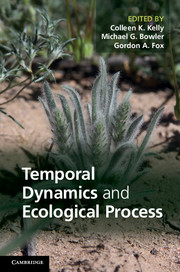Book contents
- Frontmatter
- Contents
- List of Contributors
- 1 Introduction
- Part I Observing temporal processes in nature
- 2 The storage effect: definition and tests in two plant communities
- 3 What temporal processes in trees tell us about competition, community structure and speciation
- 4 Testing the storage effect with long-term observational data
- 5 Seedling herbivory and the temporal niche
- 6 Temporal variation in density dependence in an herbaceous community
- 7 Population and community dynamics in variable environments: the desert annual system
- 8 Temporal niches, ecosystem function and climate change
- Part II Application to specific questions
- Index
- References
3 - What temporal processes in trees tell us about competition, community structure and speciation
Published online by Cambridge University Press: 18 December 2013
- Frontmatter
- Contents
- List of Contributors
- 1 Introduction
- Part I Observing temporal processes in nature
- 2 The storage effect: definition and tests in two plant communities
- 3 What temporal processes in trees tell us about competition, community structure and speciation
- 4 Testing the storage effect with long-term observational data
- 5 Seedling herbivory and the temporal niche
- 6 Temporal variation in density dependence in an herbaceous community
- 7 Population and community dynamics in variable environments: the desert annual system
- 8 Temporal niches, ecosystem function and climate change
- Part II Application to specific questions
- Index
- References
Summary
Introduction
This chapter reviews evidence concerning the vital role that temporal dynamics can have in the ecology of trees and other long-lived species in the assembly and maintenance of natural communities. The research synthesised here was stimulated by a desire to determine the action of temporal dynamics in nature, and its implications for the nature of competition, community structure and assembly on multiple scales and across a range of climatic conditions. For the most part, the results discussed concern tropical forests, but we think they provide strong support for a more general view that can be applied across biomes. Finally, we ask if there may be a potential role for temporal dynamics in speciation, in light of what we have learned from the tropical trees.
A field programme begun in the late ’90s in the tropical dry forest of México was consciously designed to study the coexistence of closely related species in a very speciose community, but the role of temporal dynamics had not been suspected and its finding was serendipitous. With centuries-long lifespans, decades-long juvenile stages and low population turnover rates, trees are problematic candidates for demographic analyses, either observational or experimental. Unless instant death is involved, the particular hurdle with trees, as with any long-lived organism, is directly connecting any specific response in the early life of the individual with the long-term individual persistence or character of the standing population. However, trees differ from many long-lived organisms in carrying their history in their structure at both the individual and population levels. Thus, a tree population itself documents individual success over the history of the population (Parker et al. 1997, Cole et al. 2011). The distribution of a population with regard to physical conditions, size and age structure and relative to other woody species all contain information on the ecology and interactions of species (e.g. Veblen 1989, 1992, Villalba and Veblen 1998, Kelly et al. 2001) and it was the age structure of populations that revealed the action of temporal dynamics at Chamela Biological Station.
- Type
- Chapter
- Information
- Temporal Dynamics and Ecological Process , pp. 41 - 81Publisher: Cambridge University PressPrint publication year: 2014



